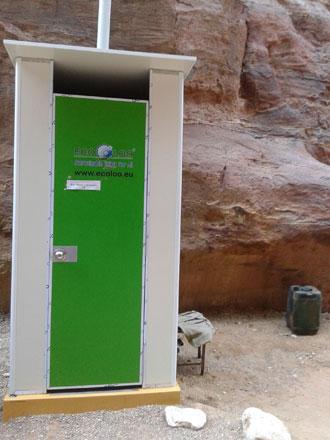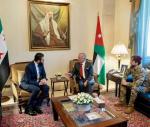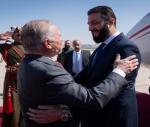You are here
Projects launched to conserve biodiversity, develop tourist sites
By Merza Noghai - Apr 04,2016 - Last updated at Apr 04,2016

A man passes by little Petra in this photo taken this week (Photo by By Merza Noghai)
PETRA — In 2008, local community members met to discuss a project aimed at protecting the natural heritage in Petra, which resulted in some recommendations the UNDP adopted in 2014.
On Sunday, a ceremony was held in the red-rose city to launch the project.
Called “Mainstreaming biodiversity conservation in tourism sector development in Jordan”, the project covers three locations: Dibbeen Forest Reserve, Rum Reserve and Petra Reserve, said Majid Hasanat, the project manager.
The scheme is implemented by the UNDP and is financed by the Global Environment Facility, which contributed $3.5 million.
Sunday marked the launch of several activities and projects in Petra to help the area’s tourism sector flourish again, said Hasanat, highlighting that the project is executed at national, regional and local levels.
“At national level, the project management is currently revising laws and legislation regulating the tourism activities in the Kingdom, and seeks to embed the concept of biodiversity conservation in tourist activities,” he said.
Within the regional scope, which covers the northern, central and southern regions of the Kingdom, the manager, an agricultural engineer, said the project focuses on building up the capacities of project partners to preserve biodiversity and regulate the use of land in their regions.
The tourism and municipal affairs ministries, Petra Development and Tourism Region Authority (PDTRA), Aqaba Special Economic Zone Authority and the Royal Society for the Conservation of Nature are partners in the effort, which is being implemented between 2014 and 2018, said Hasanat.
At the local level, in Petra, the UNDP, in cooperation with the PDTRA, will carry out several activities aimed at protecting biodiversity in the area, he said.
“Such activities include declaring Petra as a national nature reserve, developing visitor centres and implementing interactive activities to acquaint Petra visitors with the importance of the area’s natural value,” Hasanat noted.
UNDP Country Director Zena Ahmad told attendees, who consisted of media representatives, local community members and Petra officials, that the project also includes installing guiding signs at archaeological sites, building visitor centres and providing 500 vests for service providers to make it easier for tourists to spot them.
The project also entails installing environment-friendly toilets in places that lack such facilities, a first in Jordan, said Ahmad, adding that these are able to convert waste into organic fertilisers.
“The UNDP will also cooperate with PDTRA in producing short films to promote Petra’s historical and natural values, that will be shown to tourists in the Petra Visitor Centre,” added Ahmad.
The project staff has executed many surveys and field studies in Petra, which showed a “great level of richness” in natural components, with the aim of rendering Petra a nature reserve, the country director noted, highlighting that the studies “qualify Petra to be at the top nature reserve at national level”.
PDTRA Chief Commissioner Mohammad Nawafleh said that local projects, including those implemented in cooperation with UNDP, seek to organise the tourist activity at archaeological sites and enhance the tourists’ experience in a way that benefits both visitors and the local community.
“Planning for key projects in PDTRA contributes to diversifying the tourist product, making tourists stay for longer time and enhances financial revenues for investors and the local community,” Nawafleh said.
Imad Hijazin, PDTRA vice-chief commissioner and commissioner of the Petra Archaeological Park, said the new projects come in line with new PDTRA Law, which aims at developing the region, achieving sustainable development, creating an environment that attracts investment and offering a unique tourist product.
“Jordanian tourism started in this place nine decades ago, when Petra received the first organised tourist group to the Kingdom,” said Hijazin, stressing that the PDTRA will do its utmost to preserve archaeological sites and acquaint the world with them.
President of the Jordan Society of Tourism and Travel Agents Shaher Hamdan said that some of the challenges facing the tourism sector are related to laws. The society he heads seeks to overcome them by meeting with lawmakers, thus hoping to attract more tourists to Jordan.
Related Articles
PETRA — Although some 80 per cent of Jordan’s area is arid, the Kingdom’s location between three continents — Asia, Africa and Europe — give
PETRA — In what has been called a “benchmark” decision, the rose-red city of Petra on Tuesday joined the National Protected Areas Network, a
WADI MUSA — Representatives of the United Nations Development Programme (UNDP) in Jordan gathered on Thursday in Wadi Musa with member

















